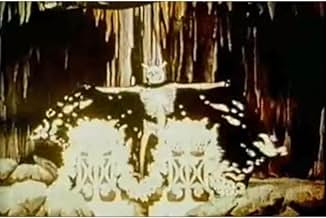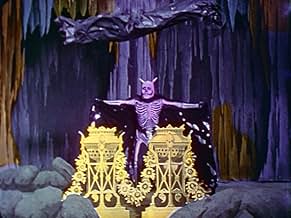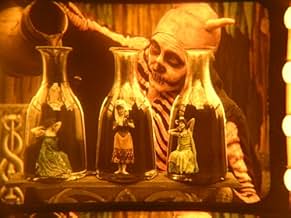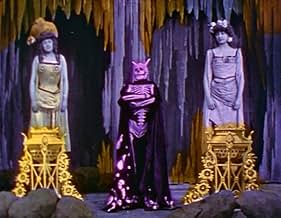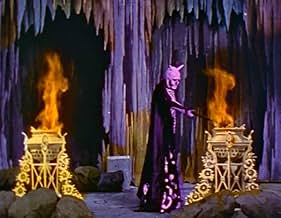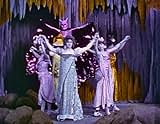AVALIAÇÃO DA IMDb
6,5/10
1,3 mil
SUA AVALIAÇÃO
Adicionar um enredo no seu idiomaA demonic magician attempts to perform his act in a strange grotto, but is confronted by a Good Spirit who opposes him.A demonic magician attempts to perform his act in a strange grotto, but is confronted by a Good Spirit who opposes him.A demonic magician attempts to perform his act in a strange grotto, but is confronted by a Good Spirit who opposes him.
Avaliações em destaque
The Red Spectre is a trick film from France in the style of Georges Méliès; although this one was directed by Ferdinand Zecca. It has all of the visual invention you would expect and it also has a nice red coloured tint which is perfect for its atmosphere.
It's set in an underground cavern and features a demon warlock. This evil character possesses souls of several women. He manipulates them in several ways and generates television-like screens. All the while he is counterbalanced by a female nemesis that thwarts his evil actions and ultimately destroys him.
It may be a short film but it's full to the brim with visual ideas. Characters appear and disappear, are shrunken and burst into flames. Walls are constructed and turn into giant monitors and rock faces move aside to show a cavern full of hell-like fires. It's relentlessly inventive basically. Worth seeing if you like the visual innovation of the earliest days of cinema.
It's set in an underground cavern and features a demon warlock. This evil character possesses souls of several women. He manipulates them in several ways and generates television-like screens. All the while he is counterbalanced by a female nemesis that thwarts his evil actions and ultimately destroys him.
It may be a short film but it's full to the brim with visual ideas. Characters appear and disappear, are shrunken and burst into flames. Walls are constructed and turn into giant monitors and rock faces move aside to show a cavern full of hell-like fires. It's relentlessly inventive basically. Worth seeing if you like the visual innovation of the earliest days of cinema.
Here's Segundo de Chomon challenging Melies as the master of the trick film, using the sort of magician's act that Melies did. It's a combination of stage magic and movie magic -- if you look carefully, you can see the moments when the camera stops and something is substituted.
Because whenever Melies got before the cameras and did his act -- he was a stage magician and had gotten into making movies to fill up the show at his Theatre Robert-Houdin -- you could see his pleasure in performing, there was no way that de Chomon could match that. So he stuck his unnamed performing in a skeleton costume with horns and a cape. It's so over-the-top that it's magnificent.
Because whenever Melies got before the cameras and did his act -- he was a stage magician and had gotten into making movies to fill up the show at his Theatre Robert-Houdin -- you could see his pleasure in performing, there was no way that de Chomon could match that. So he stuck his unnamed performing in a skeleton costume with horns and a cape. It's so over-the-top that it's magnificent.
This is one of the weirdest films I've ever seen from the filmmaker Segundo de Chomón--and much of this is because the film is set in Hell and the leading man is the Devil himself! Interestingly, he looks much more like a skeleton than 'Ol Scratch and he is bored. In fact, he's so bored that he decides to put on a magic show! Assisted by his main squeeze (Julienne Mathieu--the director's wife), the Devil does one trick after another after another. In fact, there are so many that it's fatiguing. It's much like watching three or four of Georges Méliès films (who Chomón is clearly copying from) and stringing them into one long film.
The film has some serious pluses--nice costumes, terrific sets and a weirdness that is wonderful. A huge minus that Chomón isn't innovating here but is 'copying' the work of another man--using a lot of the tricks innovated by Méliès. Fortunately, however, he still manages to make a very nice film.
The film has some serious pluses--nice costumes, terrific sets and a weirdness that is wonderful. A huge minus that Chomón isn't innovating here but is 'copying' the work of another man--using a lot of the tricks innovated by Méliès. Fortunately, however, he still manages to make a very nice film.
The first decade of the twentieth century saw the production of dozens of brief "trick films" which pushed the boundaries of the new medium, and France was the capital of this activity. Georges Méliès is the best known creator of these films, but The Red Spectre, which was produced at the Pathé Studio as a collaboration between Méliès' fellow pioneers Ferdinand Zecca and Segundo De Chomon, is perhaps the most bizarre and fascinating of them all. Or at least, allowing for the fact that so many of these films are lost, it certainly ranks with the best of the survivors. It is better seen than described, genuinely dreamlike in its images and transitions, and quite strange, but quite satisfying as well. The action lasts only about 8 or 9 minutes, but when it's over you feel as if you've been permitted to visit another world. When The Red Spectre was first exhibited the black & white footage was hand-colored to produce a dazzling effect, and happily, this material survives: a color print was discovered in a junk-yard in Mexico, and purchased for $25.00!
Our setting is a mysterious underground grotto, and our "host" is a demonic magician who seems to be toying with the souls or spirits of several captive women. He causes them to levitate, then burst into flames; he captures their ashes in bottles, brings them back to life in miniaturized form, etc. The magician is opposed throughout by a Good Fairy who resembles Peter Pan (portrayed by a woman, as Peter traditionally is on stage). The precise meaning of the action is difficult to determine at times, but the central conflict amounts to a struggle between the forces of Good and Evil.
One effect is especially notable: when the wicked magician produces three glass bottles, each holding a tiny woman prisoner, and brings them downstage to allow for a close-up, the scene instantly reminds latter day viewers of a similar sequence in The Bride of Frankenstein (1935). Did James Whale see this film, or is the similarity a coincidence? Notable, too, is the depiction of a device very much like television-- strongly suggested by the evil conjurer's magic screens, each of which depicts a series of moving images. Here's a real cinematic milestone: a film that predicts the coming of T.V., and, on top of that, attributes its invention to a demon!
Our setting is a mysterious underground grotto, and our "host" is a demonic magician who seems to be toying with the souls or spirits of several captive women. He causes them to levitate, then burst into flames; he captures their ashes in bottles, brings them back to life in miniaturized form, etc. The magician is opposed throughout by a Good Fairy who resembles Peter Pan (portrayed by a woman, as Peter traditionally is on stage). The precise meaning of the action is difficult to determine at times, but the central conflict amounts to a struggle between the forces of Good and Evil.
One effect is especially notable: when the wicked magician produces three glass bottles, each holding a tiny woman prisoner, and brings them downstage to allow for a close-up, the scene instantly reminds latter day viewers of a similar sequence in The Bride of Frankenstein (1935). Did James Whale see this film, or is the similarity a coincidence? Notable, too, is the depiction of a device very much like television-- strongly suggested by the evil conjurer's magic screens, each of which depicts a series of moving images. Here's a real cinematic milestone: a film that predicts the coming of T.V., and, on top of that, attributes its invention to a demon!
Director Segundo de Chomon's THE RED SPECTRE is a wonderful, subterranean magic show, put on by the skeletal entity of the title. It features various female subjects in various tricks and fantastical situations.
Mr. De Chomon once again shows his sense of humor, along with his love of the supernatural. The special effects are, as always, some of the best of the era. Of special interest are the women in the bottles, the flip-screen images, and the reverse-action wall-building sequences.
Horror fans should find this short film fascinating, since it is one of the vintage examples of what was yet to come...
Mr. De Chomon once again shows his sense of humor, along with his love of the supernatural. The special effects are, as always, some of the best of the era. Of special interest are the women in the bottles, the flip-screen images, and the reverse-action wall-building sequences.
Horror fans should find this short film fascinating, since it is one of the vintage examples of what was yet to come...
Você sabia?
- CuriosidadesHas a link to the Assassino do Zodíaco (2005) case. A letter allegedly sent by the Zodiac Killer, who may have been a film buff, was signed "The Red Phantom" and could have referred to this film or to the color "Masque of the Red Death" sequence in Lon Chaney's 1925 O Fantasma da Ópera (1925).
Principais escolhas
Faça login para avaliar e ver a lista de recomendações personalizadas
Detalhes
- Tempo de duração9 minutos
- Cor
- Mixagem de som
- Proporção
- 1.33 : 1
Contribua para esta página
Sugerir uma alteração ou adicionar conteúdo ausente

Principal brecha
By what name was A Diversão de Satã (1907) officially released in India in English?
Responda
